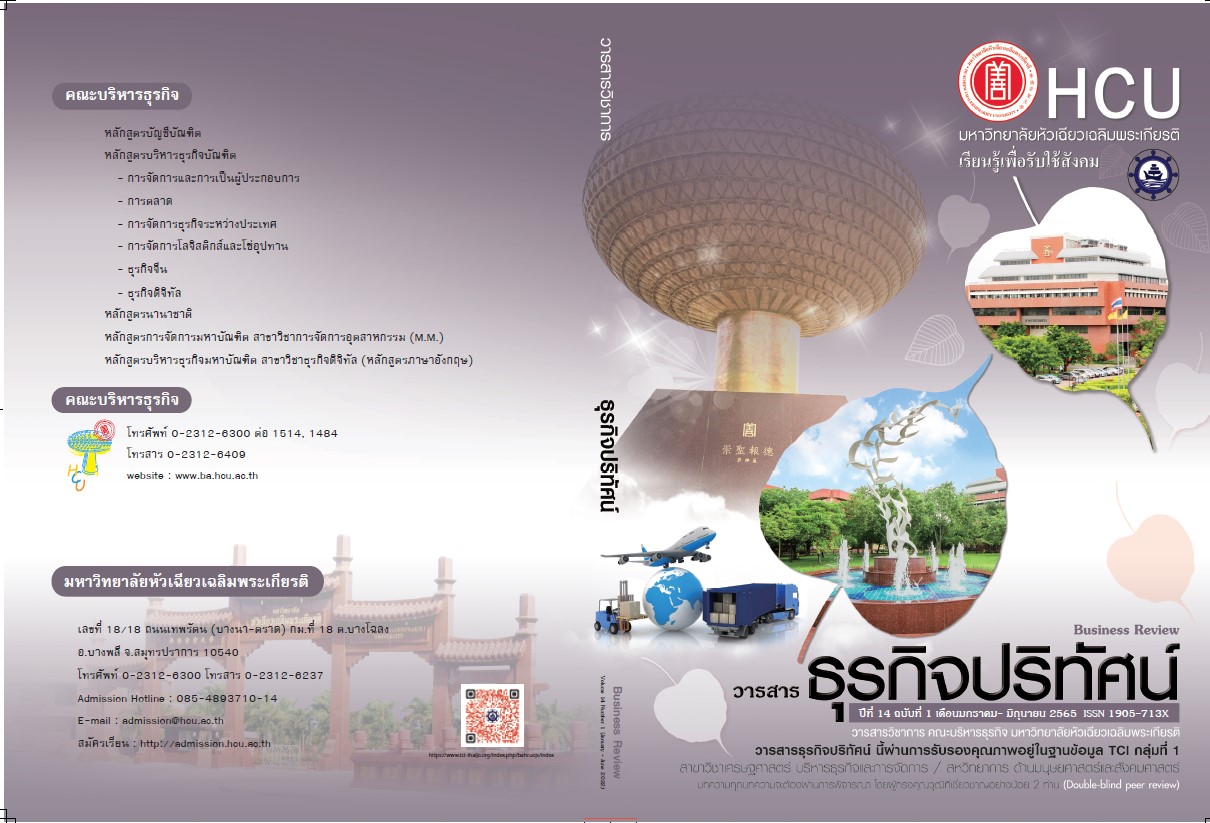Context and Linkage Strategies for Developing Innovation Management in the Thai Textile and Garment Industry
Keywords:
Strategy, Connectivity, Innovation development, Textile and Garment industry.Abstract
The main purposes of the research were 1) to study the strategic connection with the development of innovation in the Thai textile and garment industry and 2) to study the ability to create innovative management of Thai textile and garment enterprises. The sample of this research were 371 companies , using questionnaires as tool for data collection. Data were analyzed by quantitative methods. The descriptive statistics using frequency, percentage, mean and standard deviation. The analysis of variable element indicators was observed in the measurement model, using the Structural Equation Modeling (SEM. Preliminary data analysis It was found that most of them were medium-sized establishments 67.39 percent, Registered limited partnership 51.76 percent, Duration of business operations between 11-15 years 49.60 percent and Business that is sold in foreign countries 77.63 percent.
The study showed that Strategic linkages of 1 variable from 5 variables . Is the Strategy 4. Develop marketing potential for textile and garment industry entrepreneurs With a positive overall influence of 0.0022 . The development of workplace management innovation is linked to 4 variables . Consists of 1) Product innovation 2) Process Innovation 3) Marketing Innovation and 4) Organization Innovation. With a positive overall influence equal to 0.01- 0.18.
References
ชัชราวรรณ มีทรัพย์ทอง, วิโรจน์ เจษฎาลักษณ์ และจันทนา แสนสุข. (2561). ศักยภาพองค์การแห่งการเรียนรู้และความสามารถทางนวัตกรรม: หลักฐานเชิงประจักษ์ของอุตสาหกรรมธุรกิจสิ่งทอในประเทศไทย วารสารธุรกิจปริทัศน์, 10(2), 197-216.
ชูชีพ เอื้อการณ์, สมาน งามสนิท, บุญเชิด ภิญโญอนันตพงษ์ และปิยะวรรณ เลิศพานิช. (2557). แนวทางการส่งเสริมและการพัฒนาอุตสาหกรรมสิ่งทอเพื่อการแข่งขันระดับโลก. วารสารบัณฑิตศึกษา, 8(1), 35-50.
พนารัช ปรีดากรณ์ และสุภาวดี เหล่าฤทธิรัตน์. (2561). การสร้างเครือข่ายธุรกิจที่มีศักยภาพ: กรณีศึกษาเครือข่ายเครื่องนุ่งห่มและเสื้อผ้าในต่างประเทศ. วารสารวิชาการมนุษยศาสตร์และสังคมศาสตร์โรงเรียนนายร้อยพระจุลจอมเกล้า, 5(1), 95-130.
พิชิต ฤทธิจรูญ. (2552). หลักการวัดและประเมินผลการศึกษา. กรุงเทพฯ: เฮ้าส์ออฟเคอร์มิส.
มณเธียร โอทองคำ. (2561). บทบาทของอุตสากรรมสิ่งทอกับระเบียงเศรษฐกิจภาคตะวันออก (EEC). วารสารเศรษฐศาสตร์และกลยุทธ์การจัดการ, 5(1), 79-95.
สำนักงานส่งเสริมวิสาหกิจขนาดกลางและขนาดย่อม. (2559). การส่งเสริม SME ฉบับที่ 4 (พ.ศ.2560-2564) แหล่งเงินทุนเพื่อ SME. กรุงเทพฯ: สำนักงานฯ.
A Blanton Godfrey, & S. Pourmojib. (2017). Innovation, entrepreneurship and textiles. IOP Conference Series: Materials Science and Engineering, 254(21), 1-5.
Abrar, M., Deng, X., Safeer, A., Ghafoor, A., & Baig, S. (2016). E-Marketing Development and Its Application in Textile Sector of Pakistan-A Theoretical, Review January Journal of Service Science and Management, 9(3), 243-254.
Chakraborty, S. (2020). Innovative Technology Development Research by a Textile Engineer from Bangladesh, Technology Development and Sustainability: The New Era of Textile and Fashion Industries. Retrieved January 10, 2021. From Textile focus focusing textile and apparel. Website: https://textilefocus.com/technology-development-sustainability-new-era-textile- fashion-industries/
Byers, T. H., Dorf, R. C., & Nelson, A. J. (2008). Technology Ventures: From Idea to Enterprise. New York: McGraw-Hill.
ITC Communications. (2013). Women entrepreneurs in the textiles and garments industry upgrade business skills. Retrieved November 15, 2020. Form International Trade Centre. Website: https://www.intracen.org/layouts/2coltemplate.aspx?pageid=47244640256&id=47244643951
Kurz, E. (2010). Analysis on fashion design entrepreneurship: Challenges and supporting models University of Boras, Swedish School of Textiles Master of Science in Fashion Management, 6(3), 1-3.
Zhou, Lianxi. (2007). The effects of entrepreneurial proclivity and foreign market knowledge on early internationalization, Journal of World Business, Elsevier,42(3), 281-293.
Islam, Nazrul. (2002). The impact of global technological change on textile and garment and garment and garment workers of bangladesh, https://www.researchgate.net/publication/319504839_ THE_IMPACT_OF_GLOBAL_TECHNOLOGICAL_CHANGE_ON_TEXTILE_AND_GARMENT_WORKERS_OF_BANGLADESH
Nonaka, I., & Toyama, R. (2003). The knowledge-creating theory revisited: Knowledge Creation as a synthesizing process. Knowledge Management Research & Practice, 1, 2-10.
OECD. (2005). Oslo Manual: Guidelines for collecting interpreting innovation data. OECD, Paris 3, 47-50.
Rahman, M., Billah, Md M., & Hack-Polay, D. (2019). What is hindering change? Anticipating the barriers to the adoption of enzyme‐based textile processing in a developing country, Business Strategy and Development, Wiley. Online Library, 2(2), 137-147.
Walker, R. M., Damanpour, F., & Devece, C. A. (2011). Management Innovation and Organizational Performance: The Mediating Effect of Performance Management, Journal of Public Administration Research and Theory, 21(2), 367-386.
Rudrajeet, P. (2016). Sustainable Design and Business Models in Textile and Fashion Industry. Singapore: Springer Nature Singapore Pte Ltd, 2017.
Sekaran, U., & Bougie, R. (2003). Research Methods for Business, Research methods for business. (4thed). New York: John Wiley & Sons.
Office of Small and Medium Enterprises Promotion. (2015). Annual Report 2015. Bangkok: OSMEP.
Thailand Textile Institute. (2020). Cooperation Between the Support Arts and Crafts International Centre of Thailand and Thailand Textile Institute. Bangkok: Thailand Textile Institute.
Choi, W., Powell, N. B., & Cossill, N. L. (2005). New Product Development and Its Applications in Textiles, Journal of Textile and Apparel, Technology and Management, 4(4), 12-26.
Downloads
Published
How to Cite
Issue
Section
License
Copyright (c) 2022 Business Review Journal

This work is licensed under a Creative Commons Attribution-NonCommercial-NoDerivatives 4.0 International License.
All articles published in the Business Administration and Management Journal Review are copyrighted by the journal.
The views and opinions expressed in each article are solely those of the individual authors and do not represent those of Huachiew Chalermprakiet University or any other faculty members. Each author is fully responsible for the content of their own article. Any errors or issues found are the sole responsibility of the respective author.




